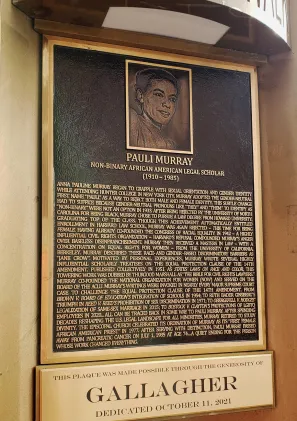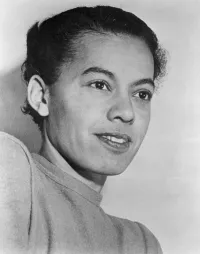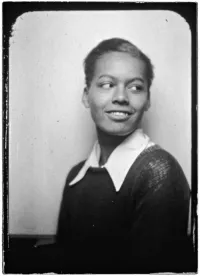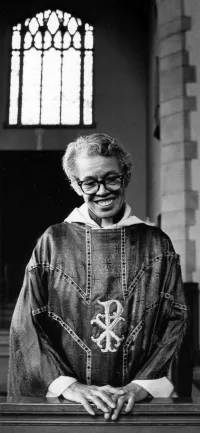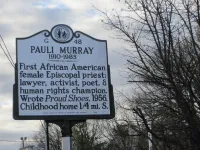Biography
1910 - 1985
"What is often called exceptional ability is nothing more than persistent endeavor."
- Pauli Murray
Anna Pauline Murray was born in Baltimore on November, 20, 1910. After high school she moved to New York City to attend Hunter College. It was during this period that Murray began to grapple with sexual orientation and gender identity. Transforming from “Anna” to the gender-neutral “Pauli”, Murray embraced neither a male or female identity – what might be described as “non-binary” today. Lacking a social circle of similarly-identified peers – or even a vocabulary with which to articulate their feelings – Murray forged ahead, undaunted. One of their first jobs out of college during the Great Depression was with the Works Progress Administration (WPA) New York City Remedial Reading Program. Rejected by the University of North Carolina for being Black, Murray studied Law at Howard University. In 1942 they co-founded the Congress of Racial Equality (CORE), an organization focused on non-violent civil disobedience. Even though Murray graduated Top of the Class at Howard, they were denied entry to Harvard’s Masters Degree program – this time for being female. Refusing again to accept baseless disenfranchisement, Murray went on to receive a post-graduate degree at the University of California/Berkley with a concentration on equal rights for women. Throughout all these discriminatory challenges – which Murray described as “Jane Crow” – they wrote several influential scholarly treatises on the Equal Protection Clause of the 14th Amendment. These were published in 1951 as States’ Laws on Race and Color… a towering work that Thurgood Marshall described as “The Bible for Civil Rights Lawyers”. Ever since, Murray’s writings have become central to the adjudication of Civil Rights cases before the U.S. Supreme Court. From Brown v. Board of Education’s integration of schools in 1954; to Windsor v. United States and Obergefell v. Hodges – both of which made Same-Sex Marriage the Law of the Land in 2015; to Bostock v. Clayton’s successful application of Title IX to cover LGBTQ people in 2020 – and countless cases in between – the most significant Civil Rights rulings of the last 70 years can all be traced back to Pauli Murray. After decades spent quietly reshaping the legal landscape of the United States for women, and racial and sexual minorities, Murray left the practice of law behind in 1977 to become the first Black woman to be ordained an Episcopalian priest. Pauli Murray passed away from pancreatic cancer on July 1, 1985 at age 74... a quiet ending for the person whose work changed everything.
1910 - 1985
"What is often called exceptional ability is nothing more than persistent endeavor."
- Pauli Murray
Anna Pauline Murray was born in Baltimore on November, 20, 1910. After high school she moved to New York City to attend Hunter College. It was during this period that Murray began to grapple with sexual orientation and gender identity. Transforming from “Anna” to the gender-neutral “Pauli”, Murray embraced neither a male or female identity – what might be described as “non-binary” today. Lacking a social circle of similarly-identified peers – or even a vocabulary with which to articulate their feelings – Murray forged ahead, undaunted. One of their first jobs out of college during the Great Depression was with the Works Progress Administration (WPA) New York City Remedial Reading Program. Rejected by the University of North Carolina for being Black, Murray studied Law at Howard University. In 1942 they co-founded the Congress of Racial Equality (CORE), an organization focused on non-violent civil disobedience. Even though Murray graduated Top of the Class at Howard, they were denied entry to Harvard’s Masters Degree program – this time for being female. Refusing again to accept baseless disenfranchisement, Murray went on to receive a post-graduate degree at the University of California/Berkley with a concentration on equal rights for women. Throughout all these discriminatory challenges – which Murray described as “Jane Crow” – they wrote several influential scholarly treatises on the Equal Protection Clause of the 14th Amendment. These were published in 1951 as States’ Laws on Race and Color… a towering work that Thurgood Marshall described as “The Bible for Civil Rights Lawyers”. Ever since, Murray’s writings have become central to the adjudication of Civil Rights cases before the U.S. Supreme Court. From Brown v. Board of Education’s integration of schools in 1954; to Windsor v. United States and Obergefell v. Hodges – both of which made Same-Sex Marriage the Law of the Land in 2015; to Bostock v. Clayton’s successful application of Title IX to cover LGBTQ people in 2020 – and countless cases in between – the most significant Civil Rights rulings of the last 70 years can all be traced back to Pauli Murray. After decades spent quietly reshaping the legal landscape of the United States for women, and racial and sexual minorities, Murray left the practice of law behind in 1977 to become the first Black woman to be ordained an Episcopalian priest. Pauli Murray passed away from pancreatic cancer on July 1, 1985 at age 74... a quiet ending for the person whose work changed everything.
Lesson Plan
Please login or register for an account to view this lesson plan.
Demography
Demography
Gender Other
Sexual Orientation Queer
Gender Identity Genderqueer/Non-Binary
Ethnicity African American Black Native/Indigenous
Faith Construct Protestant
Nations Affiliated United States
Era/Epoch Civil Rights Movement (1954-1968) Cold War (1945-1991) First-wave Feminism (1848-1930) Great Depression (1929-1939) Interwar Period (1918-1939) Progressive Era (1890-1920) Second-wave Feminism (1960-1990) Stonewall Era (1969-1974) Vietnam War (1955-1975) World War I (1914-1918) World War II (1939-1945)
Field(s) of Contribution
Author
Civics, Government, Politics, & Law
Law
Poet
Politics
Religion
Social Justice
Social Sciences
US History
Commemorations & Honors
Holy Women, Holy Men Episcopal Church General Convention Honor (2012)
Pauli Murray Childhood Home in Durham, North Carolina Named National Trust for Historic Preservation National Treasure (2015)
Pauli Murray College Designated at Yale University (2016)
Pauli Murray Family Home Designated a National Historic Landmark by US Department of the Interior (2016)
National Women's History Honoree (2018)
Episcopal Church Calendar of Saints Member (2018)
Demography
Gender Other
Sexual Orientation Queer
Gender Identity Genderqueer/Non-Binary
Ethnicity African American Black Native/Indigenous
Faith Construct Protestant
Nations Affiliated United States
Era/Epoch Civil Rights Movement (1954-1968) Cold War (1945-1991) First-wave Feminism (1848-1930) Great Depression (1929-1939) Interwar Period (1918-1939) Progressive Era (1890-1920) Second-wave Feminism (1960-1990) Stonewall Era (1969-1974) Vietnam War (1955-1975) World War I (1914-1918) World War II (1939-1945)
Field(s) of Contribution
Author
Civics, Government, Politics, & Law
Law
Poet
Politics
Religion
Social Justice
Social Sciences
US History
Commemorations & Honors
Holy Women, Holy Men Episcopal Church General Convention Honor (2012)
Pauli Murray Childhood Home in Durham, North Carolina Named National Trust for Historic Preservation National Treasure (2015)
Pauli Murray College Designated at Yale University (2016)
Pauli Murray Family Home Designated a National Historic Landmark by US Department of the Interior (2016)
National Women's History Honoree (2018)
Episcopal Church Calendar of Saints Member (2018)
Resources
Resources
Azaransky, Sarah. The Dream is Freedom: Pauli Murray and American Democratic Faith. Oxford, UK: Oxford University Press, 2011.
Bell-Scott, Patricia. The Firebrand and the First Lady, Portrait of a Friendship: Pauli Murray, Eleanor Roosevelt, and the Struggle for Social Justice. New York: Knopf: 2016.
Mayeri, Serena. Reasoning from Race: Feminism, Law, and the Civil Rights Revolution. Cambridge, MA: Harvard University Press, 2011.
Murray, Pauli. Pauli Murray: The Autobiography of a Black Activist, Feminist, Lawyer, Priest, and Poet. Knoxville, TN: University of Tennessee Press, 1989.
Pinn, Anthony, Pauli Murray: Selected Sermons and Writings. Ossining, NY: Orbis Books, 2006.
Saxby, Troy. Pauli Murray: A Personal and Political Life. Chapel Hill, NC: North Carolina University Press, 2020.
Scott, Anne Firor. Pauli Murray & Caroline Ware: Forty Years of Letters in Black and White. Chapel Hill, NC: North Carolina University Press, 2006.
Rosenberg, Rosalind. Jane Crow: The Life of Pauli Murray. Oxford, United Kingdom: Oxford University Press, 2017.
http://jesusinlove.blogspot.com/2012/07/pauli-murray-episcopal-church-votes-on.html
http://www.huffingtonpost.com/2015/02/10/lgbt-activist-pauli-murray_n_6647252.html
https://www.newyorker.com/magazine/2017/04/17/the-many-lives-of-pauli-murray
https://now.org/about/history/finding-pauli-murray/
https://medium.com/the-cross-and-the-closet/queer-saints-a-profile-on-pauli-murray-5c98a214710d
https://nmaahc.si.edu/blog-post/jane-crow-story-pauli-murray
https://www.aclu.org/issues/womens-rights/pauli-murrays-indelible-mark-fight-equal-rights
https://www.paulimurraycenter.com/who-is-pauli
https://www.womenshistory.org/education-resources/biographies/pauli-murray
https://now.org/about/history/finding-pauli-murray/
https://nmaahc.si.edu/explore/exhibitions/pauli-murrays-proud-shoes
Resources
Azaransky, Sarah. The Dream is Freedom: Pauli Murray and American Democratic Faith. Oxford, UK: Oxford University Press, 2011.
Bell-Scott, Patricia. The Firebrand and the First Lady, Portrait of a Friendship: Pauli Murray, Eleanor Roosevelt, and the Struggle for Social Justice. New York: Knopf: 2016.
Mayeri, Serena. Reasoning from Race: Feminism, Law, and the Civil Rights Revolution. Cambridge, MA: Harvard University Press, 2011.
Murray, Pauli. Pauli Murray: The Autobiography of a Black Activist, Feminist, Lawyer, Priest, and Poet. Knoxville, TN: University of Tennessee Press, 1989.
Pinn, Anthony, Pauli Murray: Selected Sermons and Writings. Ossining, NY: Orbis Books, 2006.
Saxby, Troy. Pauli Murray: A Personal and Political Life. Chapel Hill, NC: North Carolina University Press, 2020.
Scott, Anne Firor. Pauli Murray & Caroline Ware: Forty Years of Letters in Black and White. Chapel Hill, NC: North Carolina University Press, 2006.
Rosenberg, Rosalind. Jane Crow: The Life of Pauli Murray. Oxford, United Kingdom: Oxford University Press, 2017.
http://jesusinlove.blogspot.com/2012/07/pauli-murray-episcopal-church-votes-on.html
http://www.huffingtonpost.com/2015/02/10/lgbt-activist-pauli-murray_n_6647252.html
https://www.newyorker.com/magazine/2017/04/17/the-many-lives-of-pauli-murray
https://now.org/about/history/finding-pauli-murray/
https://medium.com/the-cross-and-the-closet/queer-saints-a-profile-on-pauli-murray-5c98a214710d
https://nmaahc.si.edu/blog-post/jane-crow-story-pauli-murray
https://www.aclu.org/issues/womens-rights/pauli-murrays-indelible-mark-fight-equal-rights
https://www.paulimurraycenter.com/who-is-pauli
https://www.womenshistory.org/education-resources/biographies/pauli-murray
https://now.org/about/history/finding-pauli-murray/
https://nmaahc.si.edu/explore/exhibitions/pauli-murrays-proud-shoes
